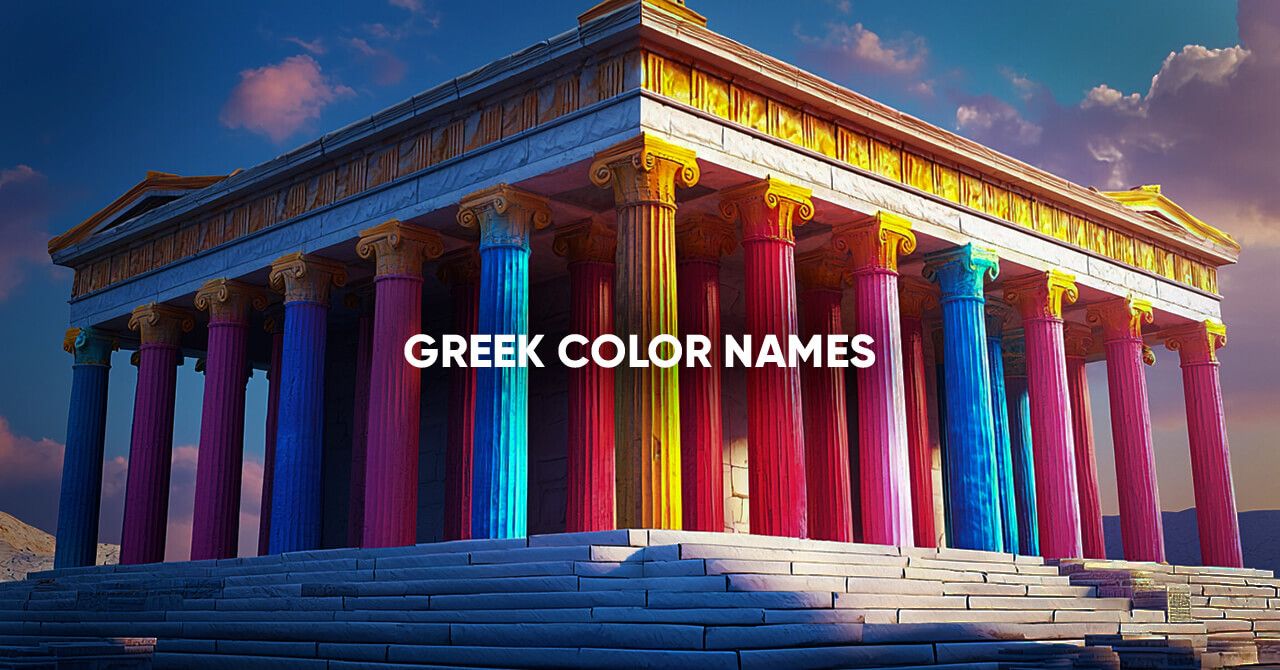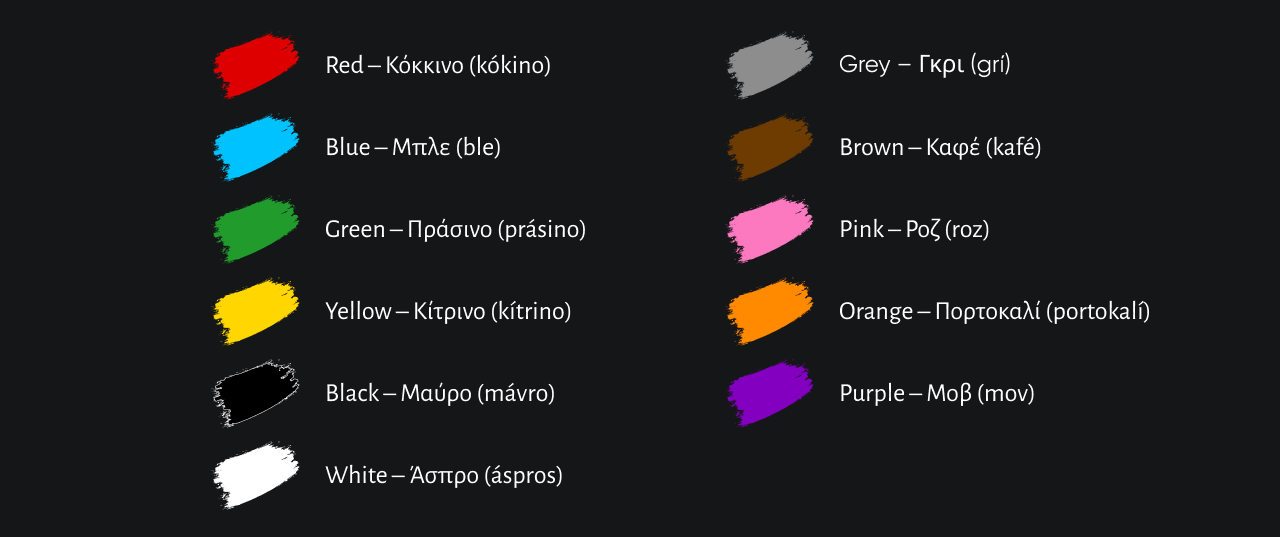
Greek Colors: How To Say Your Favorite Color in Greek
You must learn each color in Greek, as well as the adjectives used to describe them, shades and hues, symbolism, and—most importantly—some effective ways to memorize these words.
Colors are, without a doubt, an integral part of our everyday lives. It’s another way to perceive the world around us. It’s something that can elicit a variety of feelings, from calmness to excitement to even unease. While learning the vocabulary to describe the basic colors can be simple, learning how to describe different shades and hues can be quite challenging. That is also the case with colors in Greek.
Even in our native languages, it is common to be unfamiliar with the names of different shades of color. This complexity can make it quite challenging to memorize the vocabulary for colors when learning a new language, such as Greek. You must learn each color in Greek, as well as the adjectives used to describe them, shades and hues, symbolism, and—most importantly—some effective ways to memorize these words. Let’s move on to becoming color experts!
The basic colors in Greek
The first step in our journey is to learn the basic colors in Greek, meaning the colors that are universally recognized. If you are wondering how to say RGB or how to say black in Greek, then read on to find out.
But, before we get into the specific names of the colors, we should learn how to say color in Greek. So, we have:
- χρώμα (chró-mah or /’xro-ma/), which is the singular “color.”
- χρώματα (chró -ma-tah or /’xro-ma-ta/), which is the plural of “colors”
Let’s move on now to the Greek color names:

Adjectives used to describe Colors
If you are wondering, “What are Greek colors,” then you should know that knowing only the basic vocabulary is not enough. You must learn all the different shades, from plum to cypress green. While this requires a bit more mental capacity, you can count on a workaround.
Instead of scrambling, trying to find the word for sky blue or lilac, you can “cheat” slightly by using adjectives to describe the nuance of the color you want to convey. All you need to do is remember the Greek word for purple and learn a few more adjectives, such as those listed below:
- Dark = Σκούρο (skúro)
- Light = Ανοικτό (aniktó)
- Bright = Φωτεινό (fotinó)
- Dull = Θαμπό (thambó)
- Pastel = Παστέλ (pastél)
- Shiny / Glossy = Γυαλιστερό (yalisteró)
- Matte = Ματ (mat)
- Warm (tone) = Θερμό (thermó)
- Cold (tone) = Ψυχρό (psichró)
For instance, if you want to describe the “sky blue” that we mentioned above but you are short for words, you can always say ανοικτό μπλε (light blue). Or, if you try to find the word for lilac, you can say παστέλ μοβ (purple pastel).
Just try to be as descriptive as possible with the colors in Greek, and you will certainly be able to convey your message across!
How to talk about your favorite colors
The theme of “favorite colors” is a very common one, particularly in small talk or quizzes that someone may use to get to know you. Even if you want to go shopping, it is always useful to know how to express your favorite colors in Greek.
You can ask someone: “Ποιο είναι το αγαπημένο σου χρώμα;” in order to learn about their favorite colors. If someone else asks you the same, you can answer “Το αγαπημένο μου χρώμα είναι το μπλε.” It’s as easy and straightforward as that!
How to memorize Greek colors
Before we get into very specific Greek color names with shades and hues, let’s catch our breaths and discuss a bit about remembering the words we have already learned. While it is true that the easiest way to memorize something is to use it constantly and consistently, there are a few more effective memorization techniques you can employ to make your life easier. Let’s find out some ways to remember the Greek colors.
Flashcards
A very effective way to learn new vocabulary in general, which can also be applied to the names of the Greek colors, is the creation of flashcards. You can write the English color names on the one side and the Greek color names on the other side of the card and make active recall work for you! You can even color the cards to the corresponding word of the color you learn or use ink pens and highlighters.
LiveXP’s Word Trainer
Another effective tool is LiveXP’s Word Trainer feature. It will allow you to accelerate vocabulary acquisition by allowing you to learn pronunciation, spelling, and contextual usage of each Greek color. Since the application is available on smartphones, you can practice anytime, anywhere. The Word Trainer also includes pre-prepared basic word sets that cover essential colors and allow for adding custom words. This will help you leverage the spaced repetition method to your advantage.
Post-it notes
If you feel that you will benefit from constantly being in touch with the vocabulary you want to learn, then you can take the color association technique to the next level. Write the name of a color on a Post-it note and, well, post it on an item in your house that has this color. This way, every time you look at a said object, you will immediately see the name of its color in Greek.
Real-life practice
Practice is crucial in language learning. Find opportunities to practice with native-speaking Greek tutors through platforms like LiveXP. Try using color words in real-life sentences, such as discussing your favorite clothes or describing items around you. Discussing with native speakers is a great way to learn and master the Greek color names and many more different topics. With your private tutor, you can upgrade from basic conversational topics to fluent speaking in no time.
Different color shades and tones
If you have mastered the basic colors in Greek, as well as the adjectives to describe them, then there isn’t much more you need to be able to talk on this topic. However, if you want to take it a step further and be able to express the colorful world we live in, you should learn a few of the many hundreds of shades and hues. Let’s check out the most common shades.
How to say blue in Greek & shades
The color blue, a very characteristic color of Greece, is called μπλε (ble). Its most common shades derive from French and are:

- Μπλε μαρέν (ble marén) = Navy blue, blue marine
- Πετρόλ (petról) = Petrol blue
- Σιέλ (ciél) = Sky blue
- Γαλάζιο / Θαλασσί (galázio / thalasí) = Light blue, sea blueΤυρκουάζ (tirkuáz) = Turquoise
How to say green in Greek & shades
Green is a color very close to blue, and there are a few shades shared among them (like turquoise mentioned above). The word green in Greek is Πράσινο (prásino). Let’s take a look at its shades:

- Λαδί (lathí, “th” as in “there”) = olive green
- Χακί (chakí) = khaki
- Κυπαρισσί (kiparisí) = forest green / cypress green
- Λαχανί (lachaní) = cabbage green (lime)
- Βεραμάν (veramán) = celadon green, vert amande
How to say red in Greek & shades
Red is a fiery color, and it certainly has quite a lot of shades. Let’s explore the most common shades of κόκκινο (kókino):

- Κερασί (kerasí) = cherry red
- Μπορντώ (bordó) = merlot red, bordeaux
- Κοραλί (koralí) = coral red
- Βυσσινί (visiní) = sour cherry / crimson red
- Ροδακινί (rothakiní, “th” as in “there”) = peach
How to say pink and purple in Greek & shades
Even though pink and purple are shades of other colors in themselves, they have so many beautiful shades that it would be amiss if we didn’t cover them. Let’s start with the Greek words for pink and purple, which are ροζ (roz) and μοβ (mov), respectively. And now, on to their beautiful shades:

- Φούξια (fúksia) = fuchsia
- Βιολετί (violetí) = violet
- Λιλά (lilá) = lilac
- Δαμασκηνί (thamaskiní, “th” as in “there”) = plum
- Μελιτζανί (melitzaní) = aubergine
How to say yellow in Greek & shades
Yellow and orange are two colors that, even though they have many shades, most of them aren’t widely known. Let’s start with the Greek word for yellow, which is κίτρινο (kítrino), and for orange, which is πορτοκαλί (portokalí). Let’s learn a few of their shades:

- Λεμονί (lemoní) = lemon yellow
- Καναρινί (kanariní) = canary yellow
- Μουσταρδί (mustarthí, “th” as in “there”) = mustard
- Μελί (melí) = honey
- Βερικοκί (verikokí) = apricot
- Μανταρινί (madariní) = tangerine
Metal shades in Greek
Apart from these colors, there are various shades and hues in the world, and it might be just as useful to learn how these are called in Greek. The most common ones are the metal hues and shades. The three most popular ones are:

- Χρυσό (chrisó) = gold
- Ασημί (asimí) = silver
- Χάλκινο / Μπρονζέ (chálkino / bronzé) = bronze
Color symbolism in Greek
Color symbolism is the belief that colors symbolize or are associated with certain parts of aspects of our world, our emotions, culture, etc. The Greek color symbolism is not that different from the common Western one, apart from a couple of colors. Let’s see some of the colors along with the symbolisms they bear in the Greek culture:
- Blue (μπλε): The color blue is quite possibly the one bearing the greatest symbolic importance in Greek culture. Since Greece is a coastal country with numerous islands, blue symbolizes the tranquility of the sea. Furthermore, being the main color of the Greek flag, it is also closely associated with the country itself.
- White (άσπρο): The color white, the second color of the Greek flag, is also associated with the country, representing the hope. It is also considered to be the color of new beginnings and purity, and it is common in religious ceremonies, such as weddings and baptisms.
- Black (μαύρο): On the other hand, we have the color black, which is closely associated in Greek culture with mourning and loss. Black is one of the colors in Greek culture that is used in somber occasions, like funerals or the typical mourning period after someone’s passing.
- Red (κόκκινο): The color red in Greek has the same connotation as in other Western cultures—it signifies love and passion. It is mostly apparent during celebrations like Valentine’s Day and Christmas, as well as formal events. In terms of imagery, it usually signifies danger.
- Green (πράσινο): Green is the color of nature and ecology. It is associated with agriculture and ecological causes (environment preservation, recycling, etc.). In terms of imagery, it usually signifies that you are safe to go (in signs or traffic lights, for example).
- Yellow (κίτρινο): The color yellow is a color linked with spring, the sun, happiness, and warmth. Since Greece is a Mediterranean country with lots of sunlight, yellow is a color you will see a lot of!
While most colors in Greek might not have extensive cultural associations, it is still useful to know about them. Thus, you will be able to not only grasp the language better but also deepen your insight into Greek history and culture.
Conclusion
To sum it up, learning the Greek color names is an essential part of learning both the Greek language and its culture. From being able to buy your favorite color of T-shirt to expressing the most particular nuances of a work of art, knowing how to describe a color in a new language is a very important skill. By utilizing tools like LiveXP’s Word Trainer and engaging with Greek online tutors, you can effectively memorize and confidently use color vocabulary. Start with your favorite color, and you’ll learn everything else in no time!
I am a native Greek linguist, writer/editor, and academic researcher. I hold a BA in Philology and an MSc in Computational Linguistics from the University of Athens.

